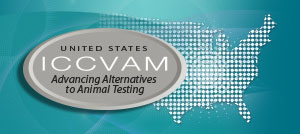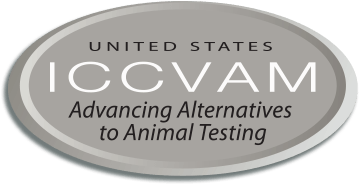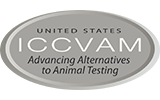Reducing or eliminating animal testing is a key goal of the 2018 ICCVAM Strategic Roadmap. To this end, ICCVAM agencies that conduct chemical safety testing develop and use approaches that reduce or replace animal use. Likewise, ICCVAM agencies that require their stakeholders to conduct testing are reducing required animal use by developing criteria for waiving tests.
Initiatives to Replace or Reduce Animal Use
Activities of the ICCVAM Consideration of Alternative Methods Workgroup
In the United States, Animal Welfare Act regulations require investigators to consider alternative methods prior to using animals for research, teaching, or testing whenever proposed procedures involve more than slight or momentary pain or distress [9 C.F.R. § 2.31 (d)(ii)(2022)]. However, there is little incentive for investigators that have long used specific in vivo models and well-established protocols to replace those models with new approach methodologies (NAMs). ICCVAM established the Consideration of Alternative Methods Workgroup to explore opportunities for encouraging investigators using animal-based models to not only consider, but actively pursue, potential NAMs that could contribute to replacing, reducing, or refining the use of laboratory animals. Virtual stakeholder meetings were held between May 2022 and May 2023 with workgroup members and stakeholder group representatives from industry, academic researchers, and academic Institutional Animal Care and Use Committee members. A common set of discussion questions was formulated and used to collect stakeholders’ perspectives on how alternatives to traditional animal tests are considered when developing their respective organization’s toxicology testing programs. These interactions revealed that many stakeholders already use NAMs for mechanistic research, justification in animal protocols, internal company decision-making, and various regulatory processes. However, they also identified barriers to using NAMs, including limited funding available for NAM development, scientific and technical challenges, regulatory acceptance and harmonization issues, as well as limited knowledge and training on NAMs. Recommendations for overcoming these barriers included ensuring fit-for-purpose use of NAMs, developing national and global harmonized acceptance criteria, identifying funding sources, and increasing awareness about the strengths and limitations of NAMs. Regulators, NAMs developers, and end-users need to increase dialogue on priorities and opportunities for NAMs. To foster increased consideration of NAMs, targeted funding opportunities are needed to develop and incorporate NAMs in research and regulatory applications. An abstract describing the activities of the workgroup (Marko et al.) has been accepted for a poster presentation at the 2024 SOT annual meeting, and the workgroup is preparing a white paper for submission to a peer-reviewed journal in 2024.
Integrating “one-health” concepts into phased approaches to toxicology data collection
Development of military-specific substances can include substances used in new weapons systems and platforms, medications for countermeasures, insect repellants, fire extinguishing agents, warfighter gear, propellants, smokes, simulators, and specialized coatings. All of these must be shown to be safe for warfighter use and be sustainable for manufacture, use, and demilitarization. DoD has developed an effective approach to providing environmental, safety, and occupational health information early in the research, development, testing, and evaluation stages for new and emerging materials (Johnson and Adams 2023). Research begins with modeling promising chemical structures in silico. These quantum mechanical models can also provide information useful for understanding environmental fate and transport and assist in understanding relevant exposure pathways. Once chemical structure information is available, toxicologists provide interpretation on toxicity using in silico models (e.g., QSARs) and read-across techniques. These data are provided to chemists selecting the optimal chemical solutions. Prospective substances are then tested using a variety of in vitro assays useful for suspected toxicity targets based on structural read-across or in silico predictions. Data from these studies are used as the basis for recommendations on progression to in vivo studies focusing on identifying toxic thresholds to protect human health and the environment, and subsequent studies for specific endpoints as needed.
Use of human data for the classification of skin sensitization hazard and potency
Regulatory entities worldwide use skin sensitization test data to classify substances for their likelihood and potency for inducing allergic contact dermatitis. One hazard classification system for this purpose is defined by the GHS. As humans are the primary species of interest for these classifications, and high-quality human data sets exist for this endpoint, it is appropriate to consider how human data might be applied to defining these classifications. Scientists with the German Federal Institute of Risk Assessment and CPSC, FDA, and NIEHS assessed the value of human predictive patch test (HPPT) data for classification of chemicals as skin sensitizers under the GHS (Herzler et al. 2024). They proposed that the dose per skin area (DSA) used for classification by the GHS to be replaced by or complemented with a dose descriptor that may better reflect sensitization incidence. Two such descriptors described in the paper are the DSA causing induction of sensitization in one individual or the DSA leading to an incidence of induction in 5% of the tested individuals. The paper also proposed standardized concepts and workflows for assessing individual HPPT results, as well as for integrating multiple HPPT results and for using them in concert with local lymph node assay data in a weight-of-evidence assessment. The study determined that HPPT results are often not sufficient for deriving unambiguous classifications on their own. However, where they are, the resulting classifications are reliable and reproducible and can be integrated well with those from other skin sensitization data.
Rethinking Carcinogenicity Assessment for Agrochemicals Project
Rodent cancer bioassays have long been required for regulatory assessment of human cancer hazard and risk. However, decades of information from chronic and carcinogenicity studies have revealed some limitations of these studies. For example, certain aspects of the assay may lack human relevance. In addition, long-term rodent bioassays are costly, time-consuming, require large numbers of animals, and can be difficult to reproduce. Human-relevant new approach methodologies (NAMs) based on an improved understanding of human cancer biology may provide a less resource-intensive and more rapid method to assess chronic toxicity and carcinogenicity when making health-protective decisions. The use of NAMs in chemical safety assessment can be achieved by way of regulatory flexibilities, including a weight-of-evidence-based approach in which studies can be waived when alternative methods or existing data are sufficient. To streamline and support approval of new technologies, scientists from government, academia, nongovernmental organizations, and industry stakeholders convened the Rethinking Carcinogenicity Assessment for Agrochemicals Project. The project developed a reporting framework (Hilton et al. 2022) to support a chronic toxicity and carcinogenicity study waiver rationale, which includes information on use pattern(s), exposure scenario(s), pesticidal mode of action, physicochemical properties, metabolism, toxicokinetics, toxicological data including mechanistic data, and chemical read-across from similar registered pesticides. The framework could also be applied to endpoints other than chronic toxicity and carcinogenicity, and for chemicals other than agrochemicals.
Retrospective analyses to reduce number of species needed for acute fish toxicity assessment for conventional pesticides
EPA uses data from the in vivo fish acute toxicity test to assess potential risk of substances to aquatic vertebrates. The test is typically conducted on a cold and a warm freshwater species and a saltwater species for a conventional pesticide registration, potentially requiring upwards of 200 or more fish. EPA and NIEHS scientists conducted a retrospective data evaluation to explore the potential for using fewer fish species to support conventional pesticide risk assessments (Ceger et al. 2023). LC50 values and experimental details were extracted and curated from 718 studies on fish acute toxicity submitted to EPA. The LC50 data were analyzed to determine, when possible, the relative sensitivity of the tested species to each pesticide. In 85% of those cases, one of the tested freshwater species was identified as the most sensitive, with the cold freshwater species being the most sensitive overall among cases with established relative sensitivity. The results support potentially using fewer than three fish species to conduct ecological risk assessments for the registration of conventional pesticides.
Retrospective analyses to reduce number of species needed for avian reproductive toxicity assessment for conventional pesticides
EPA considers chronic risk to birds when evaluating ecological risk to wildlife from the application of pesticides. These risk assessments are supported by ecotoxicity data required for pesticide registration, including data on avian reproductive toxicity (OCSPP 850.2300) in two birds: an upland game species (typically bobwhite quail) and a waterfowl species (typically mallard duck). EPA is collaborating with nongovernmental organizations and industry stakeholders on a retrospective analysis to assess species differences in sensitivity to conventional pesticides and determine the impact of the two avian test species on the ecological risk assessment. The analysis examines patterns in species sensitivity across groups of chemicals. When species differences are identified, an additional analysis is being conducted to determine if differences in species sensitivities could be reliably accounted for without testing of a second species. The goal of this project is to determine if there are factors that can be considered when determining testing requirements for conventional pesticides and if chronic risk to birds can be confidently assessed using a reduced number of test species. Results will be described in a paper to be submitted to a peer-reviewed journal in 2024.
Retrospective analyses to reduce number of tests needed to assess honeybee toxicity for conventional pesticides
EPA ecological risk assessments for pesticide registration include a summary of potential risks to bees. Toxicity data are submitted to support these assessments, and EPA maintains a database containing acute and chronic toxicity data on adult and larval honeybees (Apis mellifera), which EPA considers a surrogate for Apis and non-Apis bees. EPA compared these toxicity data to explore possible trends and assess whether efficiencies can be gained in targeting the specific studies needed for risk assessment (Farruggia et al. 2022). The analysis provided evidence that compounds with a low acute (single exposure) toxicity for adults through contact and oral exposure pathways may still be toxic for adults and larvae following chronic (repeat) oral exposure. For example, the acute toxicity of herbicides and fungicides was lower for adult versus larval honeybees, and chronic toxicity studies resulted in more sensitive endpoints in larvae than adults, indicating increased sensitivity of larvae.
Value-of-information framework to inform an EPA toxicity testing strategy
Value-of-information analysis is a systematic approach to determine the “value of information” in economic terms. It allows comparison of “what we already know” and “what we will know” to determine which data generation methodologies are most valuable for decision-making. While the potential application of value-of-information analysis for toxicology has been discussed for a number of years, practical applications of such an analysis in toxicology to real-world problems are lacking. EPA and collaborators developed a value-of-information framework for assessing the trade-offs associated with uncertainty, duration, and cost of chemical toxicity testing (Hagiwara et al. 2023). A novel feature of this framework was the inclusion of a time dimension that permits incorporation of the cost of delay in incorporating additional information. A case study applied this framework to compare a short-term in vivo transcriptomic assay approach to developing protective reference doses with the traditional chronic rodent bioassay and human health assessment process. A panel of the EPA Board of Scientific Counselors was convened to assess the scientific rigor of this case study and the resulting conclusions. The case study was presented at a public meeting of the panel in July 2023, and the panel’s report and recommendations will be published in early 2024.
Availability of NAMs in the Endocrine Disruptor Screening Program
The EPA’s Endocrine Disruptor Screening Program employs a two-tiered approach. Tier 1 uses 11 screening assays to identify the potential of a chemical substance to interact with the estrogen, androgen, or thyroid pathways. Tier 2 testing is designed to identify any adverse endocrine-related effects caused by the substance and establish a dose-response relationship for any adverse estrogen, androgen, or thyroid effect. Given the large number of chemical substances covered by the EDSP, research efforts have focused on the development and evaluation of new approach methodologies (NAMs) for use as alternatives to the current suite of assays in the EDSP Tier 1 battery to accelerate the pace of screening, add efficiencies, decrease costs, and reduce animal testing.
In January 2023, EPA released a draft whitepaper for public comment on the availability of NAMs in the EDSP that describes validated NAMs, including those incorporated into the estrogen receptor and androgen receptor pathway models, that EPA may now accept as alternatives for certain EDSP tests. Additional NAMs were identified for potential use in prioritization or for consideration as Other Scientifically Related Information in weight-of-evidence evaluations. After considering public comments, EPA will issue a finalized document.
Additionally, in October 2023, EPA announced the availability of near-term strategies to help the agency meet its obligations and commitments relating to the EDSP. As part of these strategies, results from the estrogen receptor and androgen receptor pathway models were utilized as part of a prioritization framework.
Incorporation of tiered testing into TSCA Section 4 test orders on PFAS
The Frank R. Lautenberg Chemical Safety in the 21st Century Act, enacted in 2016, amended the Toxic Substances Control Act of 1976. Section 4 of the updated law authorizes EPA to issue test orders to chemical manufacturers (including importers) and processors to develop information on chemical toxicity, subject to specific requirements to reduce vertebrate animal use. One such requirement, described in Section 4(a)(4), is to employ a tiered-testing strategy. Other requirements, described in Section 4(h), directs EPA to review all reasonably available toxicity information to avoid unnecessary or duplicative testing, and to consider non-vertebrate methods where appropriate.
As of the end of 2023, EPA has issued three test orders on PFAS and plans to issue more in the near future. The PFAS test orders include in vitro tests in the tiered-testing strategy, including a respiratory tract epithelial cell culture and genotoxicity tests. One of the test orders, on a chemical known as HFPO-DAF (a precursor to GenX), contains no vertebrate testing at all. Vertebrate testing is included in Tier 2 tests for the other two PFAS test orders, but the tiered testing provides for waiving of these tests based on Tier 1 test results. Taken together, the orders demonstrate EPA’s commitment to employ non-vertebrate testing to the extent practicable and scientifically justified.
Reduction of use of dog testing for agrochemical registration
Progress in developing new tools, assays, and approaches to assess human hazard and health risk provides an opportunity to re-evaluate the need of dog studies for the safety evaluation of agrochemicals. EPA and NIEHS scientists and a diverse group of international collaborators met at a 2021 workshop to discuss the strengths and limitations of past use of dogs for pesticide evaluations and registrations (Bishop et al. 2023). Opportunities were identified to support alternatives to the 90-day dog study for answering human safety questions. Participants proposed developing a decision tree for determining when the dog study might not be necessary to inform pesticide safety and risk assessment. Such a process will require global regulatory authority participation to lead to its acceptance. The identification of unique effects in dogs that are not identified in rodents will need further evaluation and determination of their relevance to humans. The establishment of in vitro and in silico approaches that can provide critical data on relative species sensitivity and human relevance will be important in the decision. Novel tools including in vitro comparative metabolism studies, in silico models, and high-throughput assays able to identify metabolites and mechanisms of action could potentially support development of adverse outcome pathways; such tools show promise but will need further development. To replace or eliminate the 90-day dog study, a collaborative, multidisciplinary, international effort that goes beyond organizations and regulatory agencies will be needed in order to develop guidance on when the study would not be necessary for human safety and risk assessment.
FDA regulatory science tools to help assess new medical devices
FDA provides a Catalog of Regulatory Science Tools to Help Assess New Medical Devices. This peer-reviewed resource assists medical device companies to evaluate new medical devices in contexts where standards and qualified medical device development tools do not yet exist. The catalog collates a variety of regulatory science tools developed by the FDA's Center for Devices and Radiological Health's Office of Science and Engineering Labs. The tools use the most innovative science to support medical device development and patient access to safe and effective medical devices. Tools categories include lab methods, computer models, and data sets, and they are applicable to program areas including cardiovascular, neurology, and biocompatibility and toxicology. An update of the catalog is planned for early 2024.
A recent example of a qualified alternative method is the Chemical Risk Calculator (CHRIS) - Color Additives tool, which was qualified by the Center for Devices and Radiological Health in November 2022. CHRIS – Color Additives is a nonclinical assessment model to conduct screening-level risk assessments to aid in the biocompatibility evaluation of polymeric medical device components that contain color additives.



